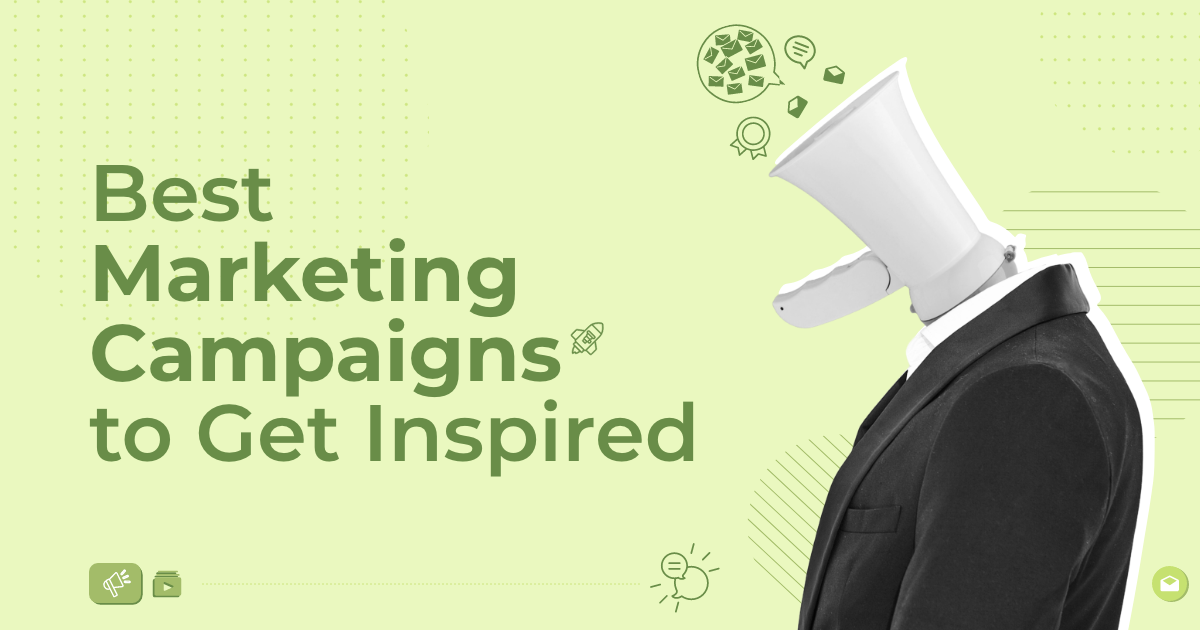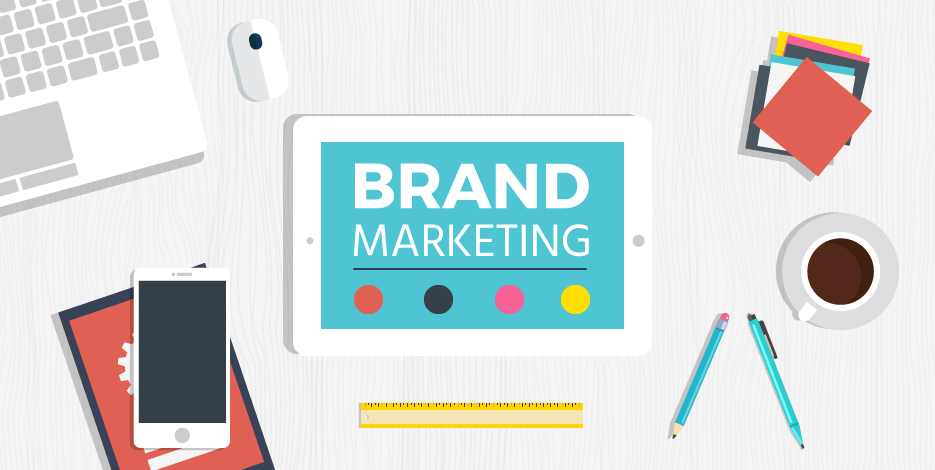
How To Build A Brand That Will Last In Time And Space [2025]
What Coca-Cola, Apple, and Nike have in common is that they knew exactly how to build a brand that consumers would love.
Do the words “brand building” scare you? Do you look at Amazon and McDonald’s and think: How can I build an equally strong brand that people will love? Is it even possible?
First of all, yes, it’s possible! And second, let me welcome you to Brand Building 101.
Today, we’ll learn everything about building a successful brand: your brand strategy, brand identity, and brand marketing!

The easiest and most affordable email marketing and newsletter software!
What Is A Brand?
A brand isn’t a fantastic beast but the way your target audience perceives your business.
For example, Christian Louboutin’s famous red-soled shoes have been in the spotlight for years. Why? Because Louboutin’s innovation is unique and intriguing! For the business, the red soles aren’t just a trademark but the very soul of the brand.
Similarly, your own brand can be a symbol, logo, font, song, or even a word that will make your target audience think of you without listening to your company name.
What Does Brand Building Involve?
Learning how to build a brand that people love isn’t rocket science. However, if you want to do it successfully, you need to know what this process involves.
The recipe to turn your business into a brand is to create a go-to-market strategy that’ll combine your brand identity and brand marketing.
Throwing all these into your mixing bowl will lead to a recognizable brand that lasts in time. So, let’s break the ingredients down:
Creating a Brand Strategy
The first step to turning your business into a brand is to develop your brand strategy.
Of course, this isn’t an easy process. Your strategy is a long-term plan that requires time, creativity, and resources.
Setting your goals is also important! Think about how your business will impact your potential customers’ lives and what solutions you can provide to their pain points.
Effective strategies should always have the following elements:
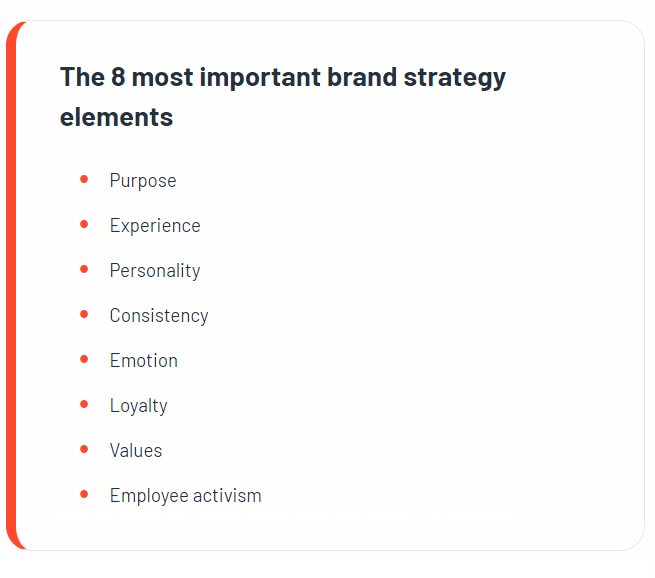
In a nutshell, your strategy should focus on delivering positive and unique experiences that will make consumers want to invest in you.
And don’t forget! The better the experience, the more people will talk about you, slowly turning you into a must-have rather than a maybe.
Constructing a Brand Identity
Your brand identity involves all the visual elements related to your brand. These can be your logo, website design, or your packaging.
However, brand identity isn’t only a box or a website but the feeling your brand will trigger when customers interact with it, to make visitors and search engines “feel safe” make sure you use an SSL certificate.
The easiest way to define brand identity is to filter a business through the brand identity prism. Here’s Starbucks’ prism:
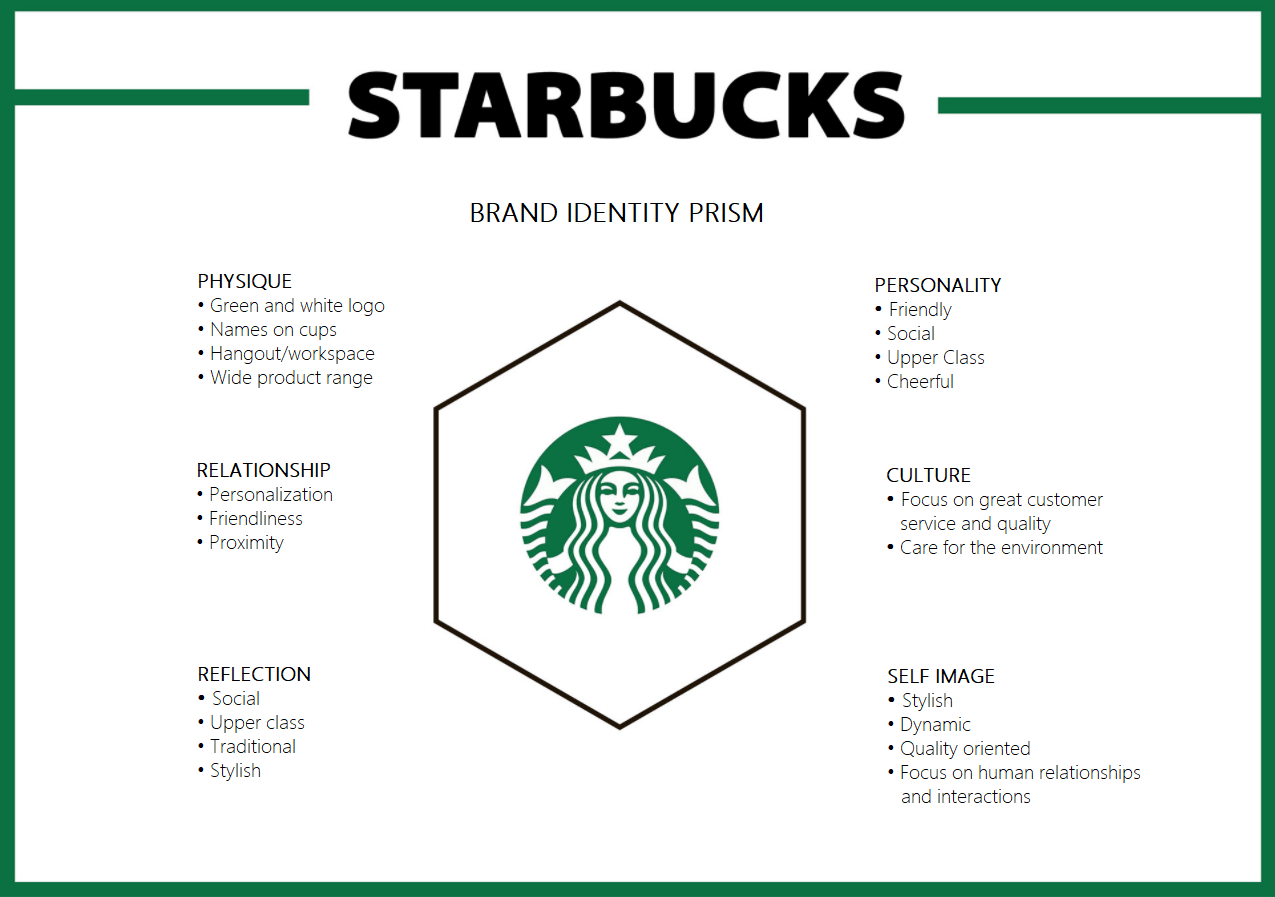
To paraphrase Jeff Bezos’ words, branding is all about your reputation and what people say about you when you aren’t there.
So, a solid brand identity that triggers positivity is your best chance to make your business thrive and survive!
Getting into Brand Marketing
Which comes first? Branding or Marketing?
Well, branding is all about the personality of your business and how you present yourself to your target audience. Marketing, on the other hand, focuses on building brand awareness through numerous digital marketing channels.
For instance, let’s say you are the owner of a beauty brand. Your branding would be something like this: “Beauty that respects nature.”
Marketing would take that and turn it into email marketing campaigns or social media posts with the reasons why customers need to buy from you.
To take a step further, your email campaign would probably look something like Burt’s Bees, a brand that has a clear purpose and doesn’t hesitate to show it:
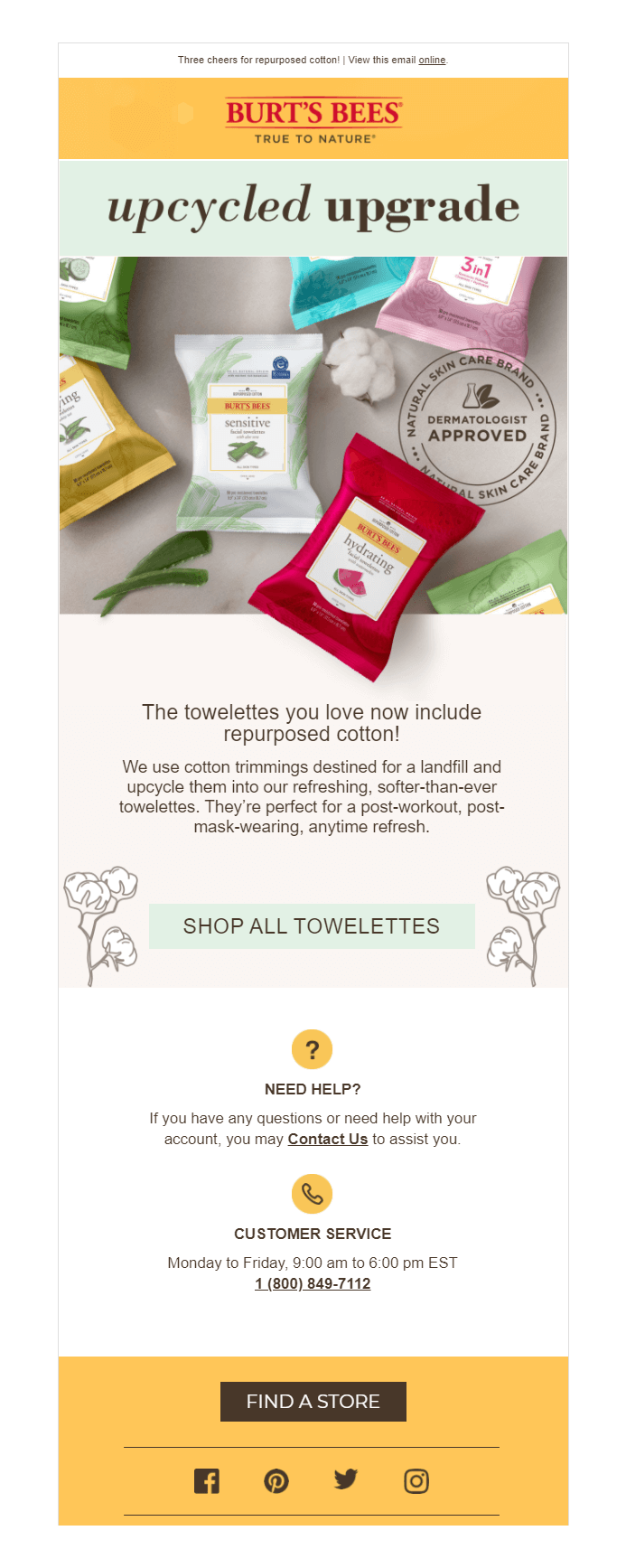
So, to answer the question of which comes first, learning how to build a brand and then getting into brand marketing is the logical thing to do.
Also, if you need an affordable email tool to start sending your emails, try Moosend to step up your brand marketing!
Now that you know about the elements of brand building, let’s see the most important steps you need to build your brand from scratch!
12 Simple Steps To Build A Memorable Brand
From setting your goals to promoting your brand through email marketing and social media, here’s all you need to create a brand that will last in time:
1. Pick A Memorable Name
Words convey meaning. But names, dear marketers, names have power!
If you want to build the ultimate brand, your starting point should be your brand name. In essence, there are no limits to what the aspiring business owner’s mind can conjure!
Picking the right name, though, isn’t an easy feat. You need to make sure that your name is easy-to-remember and hasn’t been used by other brands.
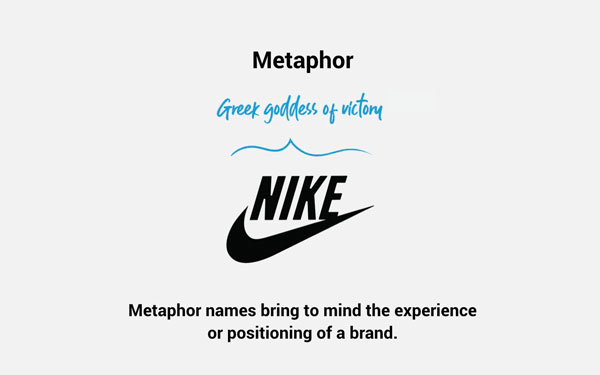
Brainstorming ideas will help you come up with the right name.
Of course, when you find the one name to rule them all, don’t forget to share it with your peers to get some feedback.
To give you an idea of what you can create, here are some categories you can focus on:
- Made-up names: Pepsi, Kodak
- Metaphor names: Nike, Amazon
- Common words/Descriptive: Apple, The Shoe Company
- Names: Wendy’s, McDonald’s
- Word combinations: Moosend, Facebook
- Acronyms: KFC, BBC
- Altered words: Tumblr, Flickr
Moreover, coming up with the perfect name might take ages. Luckily, eCommerce platforms like Shopify can help you out with their business name generators:
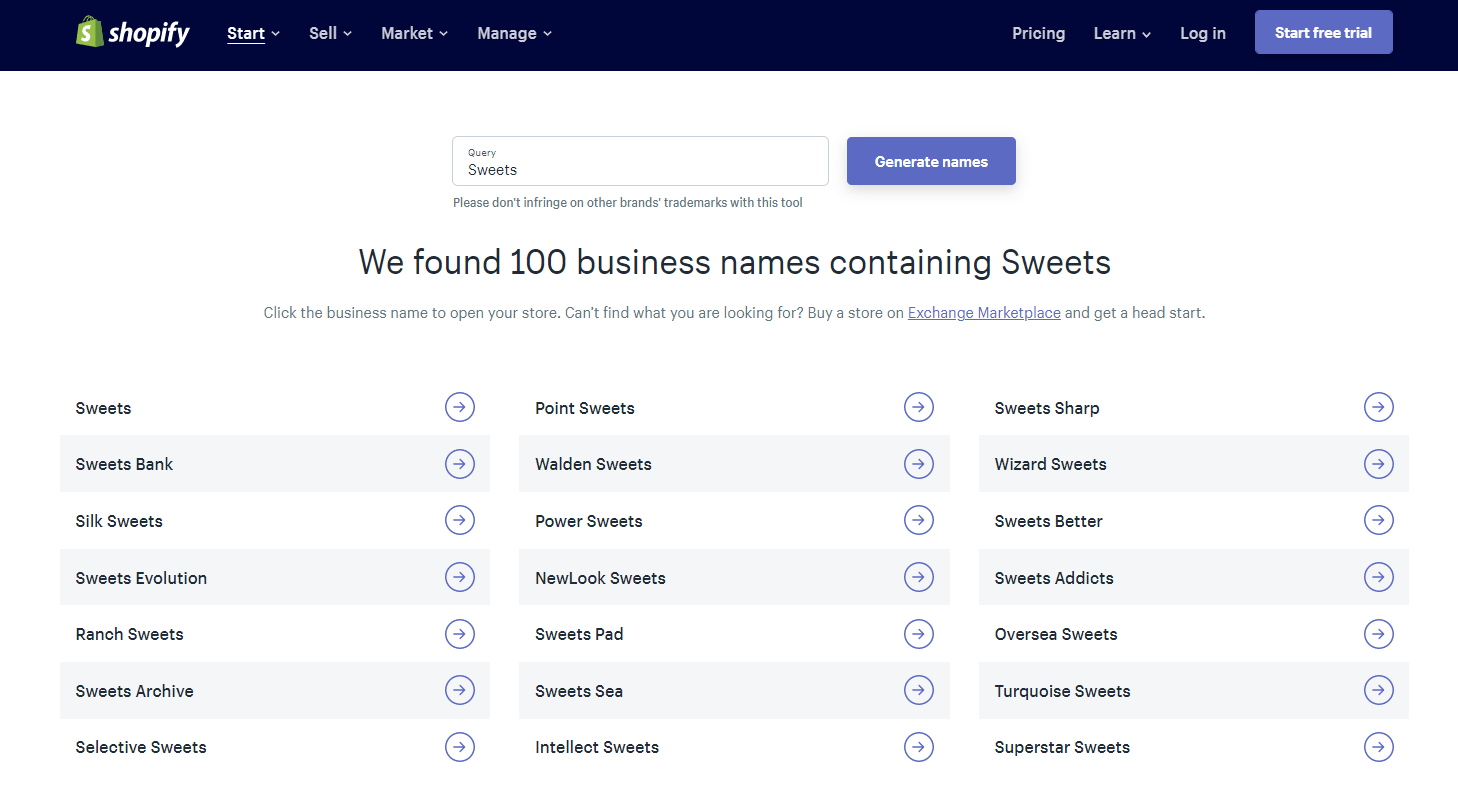
Use the generator to find a cool name when your inspiration pool has run dry. Do it wisely, though, as some can be very generic or weird!
2. Define The Purpose Of Your Brand
What are you passionate about?
Before building your brand you need to think about your mission statement.
In short, your mission consists of “what you do,” “how you do it,” and “why you do it.”
As people love supporting brands with a clear goal that transcends the make-a-profit endgame, having a mission statement that explains your vision is extremely important.
For instance, here is Patagonia’s mission statement:
“Build the best product, cause no unnecessary harm, use business to inspire and implement solutions to the environmental crisis.”
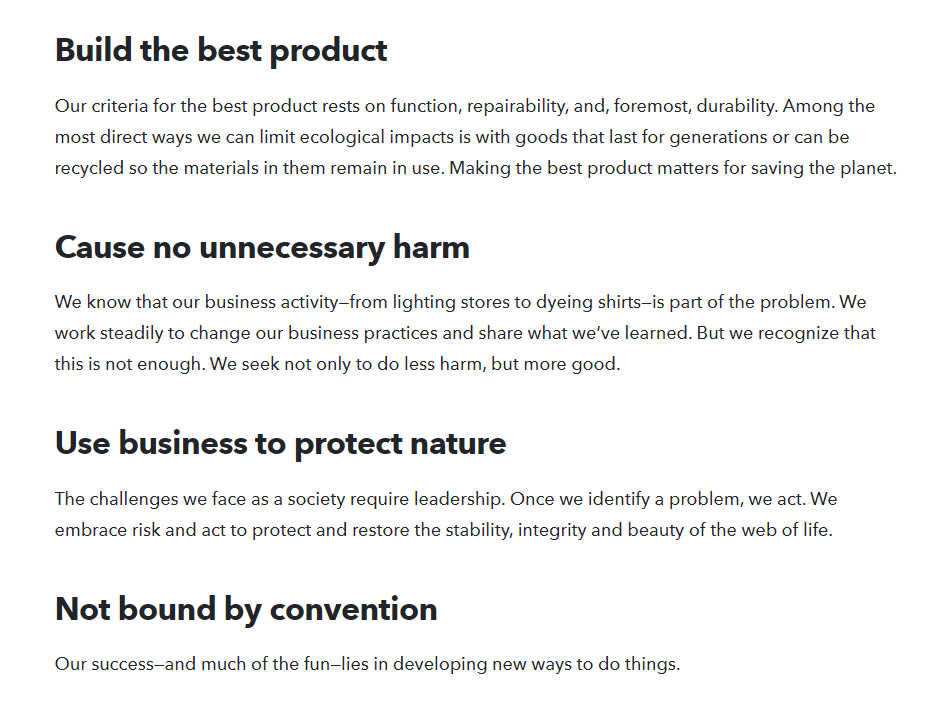
Patagonia’s mission statement perfectly embodies the company’s core values to give customers high-quality products while protecting the environment.
Keep in mind that your mission will define your brand and help you differentiate it from your competitors. So, staying true to your vision and communicating it clearly is key!
3. Create Your Brand Positioning Statement
Now, let’s talk a little about brand positioning! But wait, isn’t this the same thing as a mission statement?
Well, no. Your mission statement is all about your drive and what you and your employees want to achieve.
To understand the difference between mission statement and brand positioning, let’s examine Home Chef’s website.
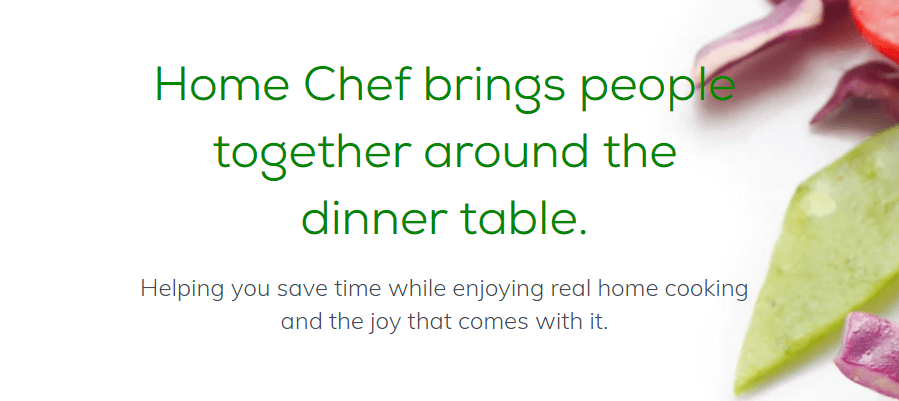
When you click on the “About Us” page you’ll come across the brand’s mission: “Bring people together around the dinner table.”
This is what Home Chef aspires to do, providing extra information about the founder’s reasons for creating the company and what he wanted to achieve.
So, if this is the mission statement, where exactly is the brand positioning statement?
Well, if you go back to Home Chef’s homepage, you’ll come across this little thing:
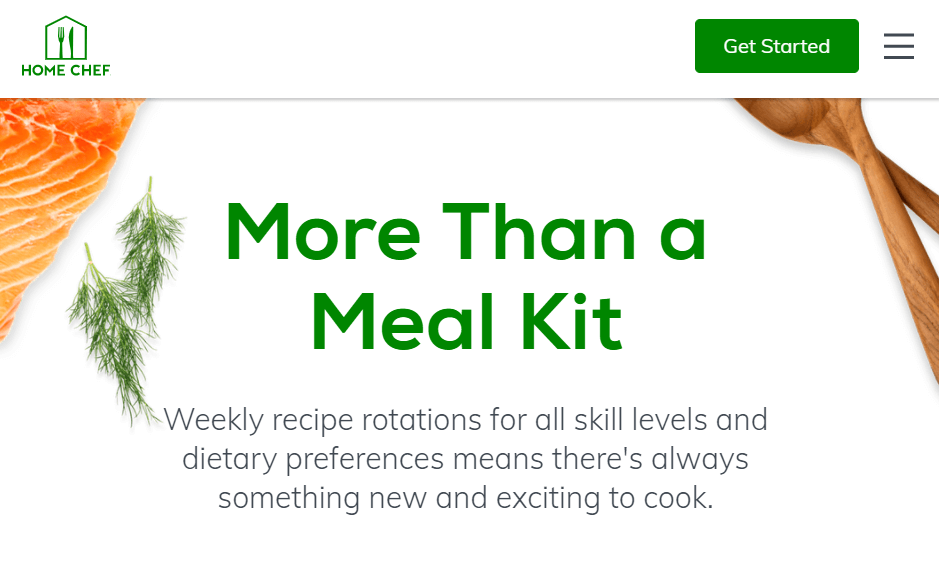
To capture your target audience’s attention, you need to put the customer first and your mission second.
So, letting the potential shopper know that the brand will simplify the way they cook, offering variety and accessibility is what they need to convert.
In a nutshell, if you want to create an effective messaging for your brand positioning statement, make it all about the value the customer will gain!
4. Do Competitive Research
After defining your purpose, you need to see what your competitors do.
Identifying your competition will help you create a more focused marketing plan to promote your business more effectively.
The best way to perform a competitive analysis is to:
- look at your competitors’ website/eCommerce store
- check old and new product prices
- analyze customer reviews to see the pros and cons of your competitors
- check their social media presence to uncover their social engagement
- Identify how your competitors market their products
- look into shipping costs and how you meet them
To top it off, don’t forget to perform a SWOT analysis to find out about the strengths and weaknesses of your competition.
For example, if your competitor is Apple, you need to study it in order to find potential gaps in its products and uncover hidden opportunities for your brand.
Here’s how Apple’s SWOT analysis looks like:
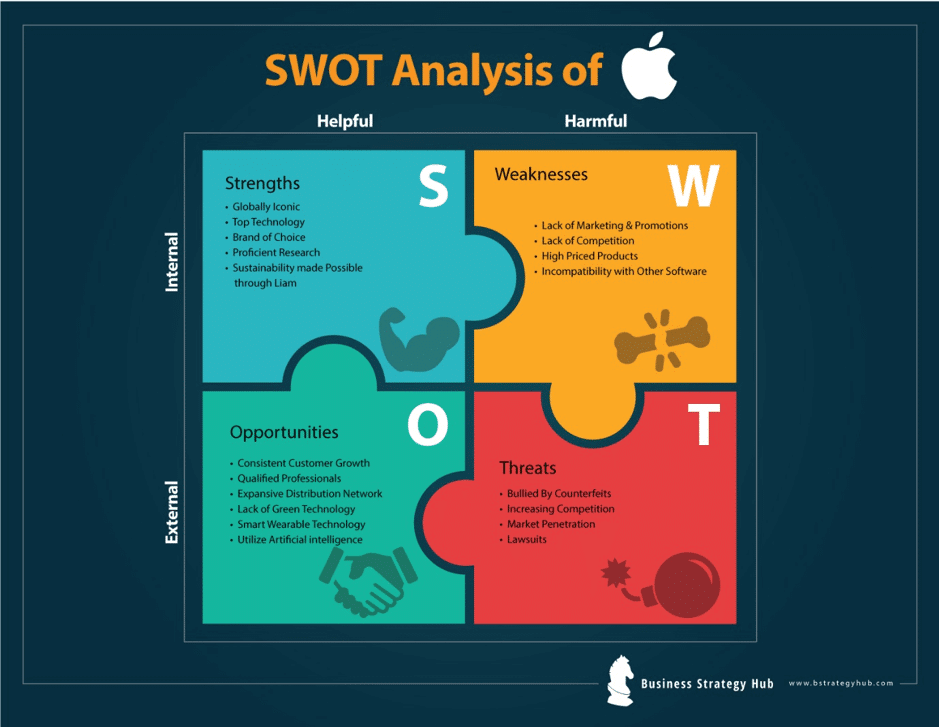
Create a Competitive Analysis Spreadsheet
Apart from your SWOT analysis, make sure to collect all your findings in a single place so you can consult them when needed.
The simplest thing is to do is to create a spreadsheet with the most important factors you will examine.
Some of the most important elements you need to discover when you learn how to build a brand are:
- Products and Price
- Quality
- Company Reputation and Culture
- Marketing and Advertising
- Reliability
Here’s a simple competitive analysis template I created, which you can use:
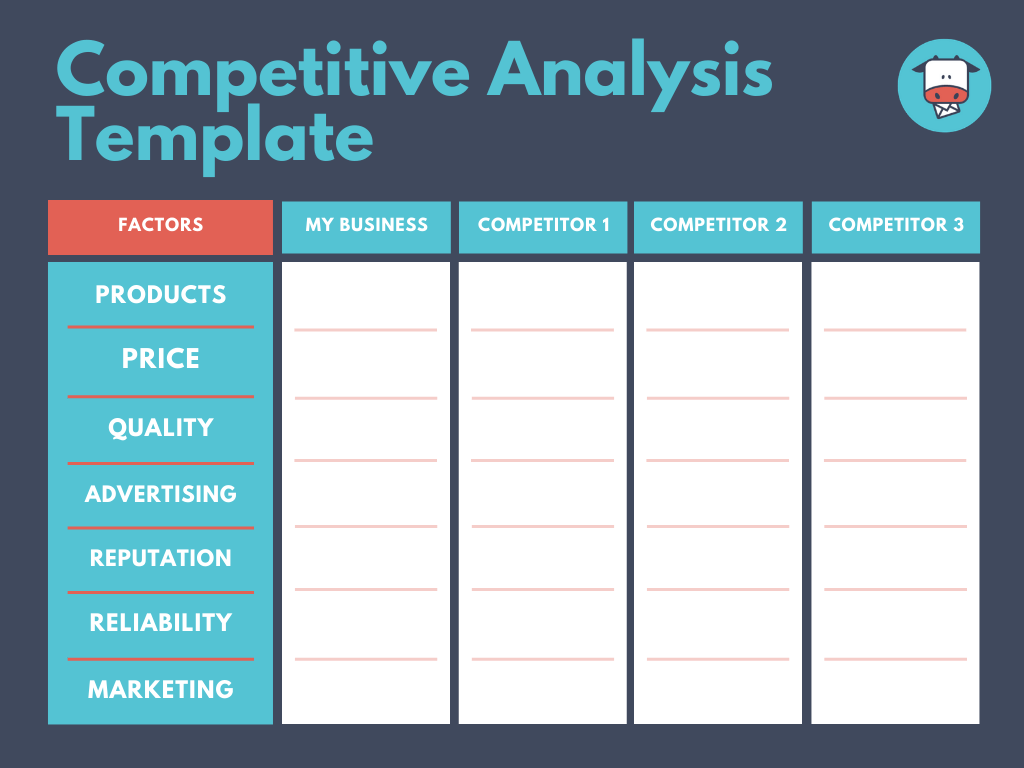
When you create your spreadsheet, you’ll have an idea of how your top competitors operate and how you can tackle the market! So, don’t forget to make one!
5. Target The Right Audience
When you examine your competitors you also need to define your target audience.
Without identifying your target market, you risk creating a brand that’ll speak to no-one.
If you think about it, the more knowledge you have about your audience, the better your branding and marketing will be.
Moreover, this way, you can select the most effective marketing channels to target them!
Here’s a simple example of a target audience profile analysis for athletic shoes you can use as a reference:
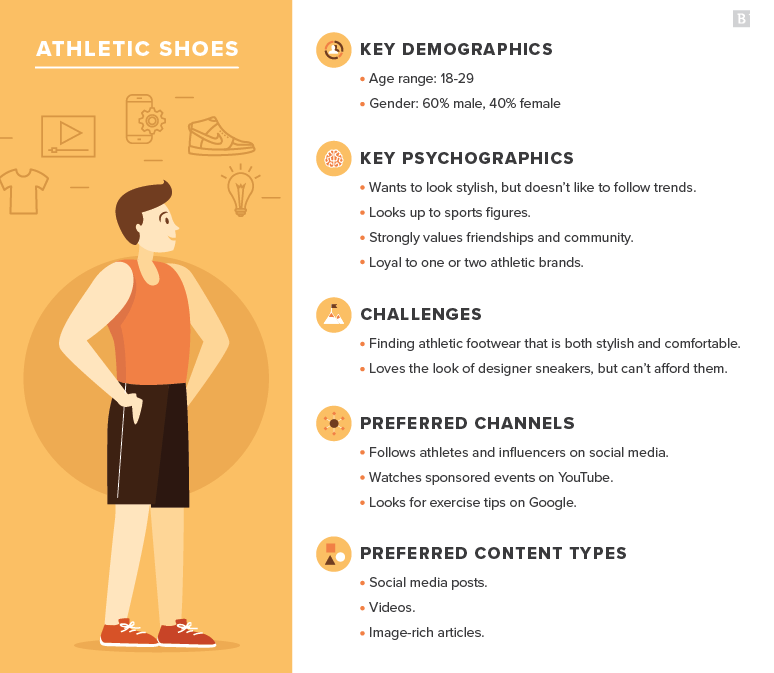
The best way to identify your audience is to target specific demographics and psychographics:
- Gender and Age
- Profession, Income, and Marital status
- Personality, Values, and Lifestyle
- Interests and Hobbies
Always keep your product in mind and how it will improve your customer’s life! Then, you can group your findings and create your target market profile.
6. Design Your Brand Logo And Tagline
I’m sure you’ve all checked out that game where you had to identify a brand’s logo.
First of all, that game is super addictive. Second, that game shows you the power of memorable brand logos!
A unique brand logo is all you need to make consumers think of your brand and products.
From the colors to the typography, every little element can play a major role in creating something that triggers certain emotions. To nail your colors, here’s a great infographic you can check out by Colourfast Printing:
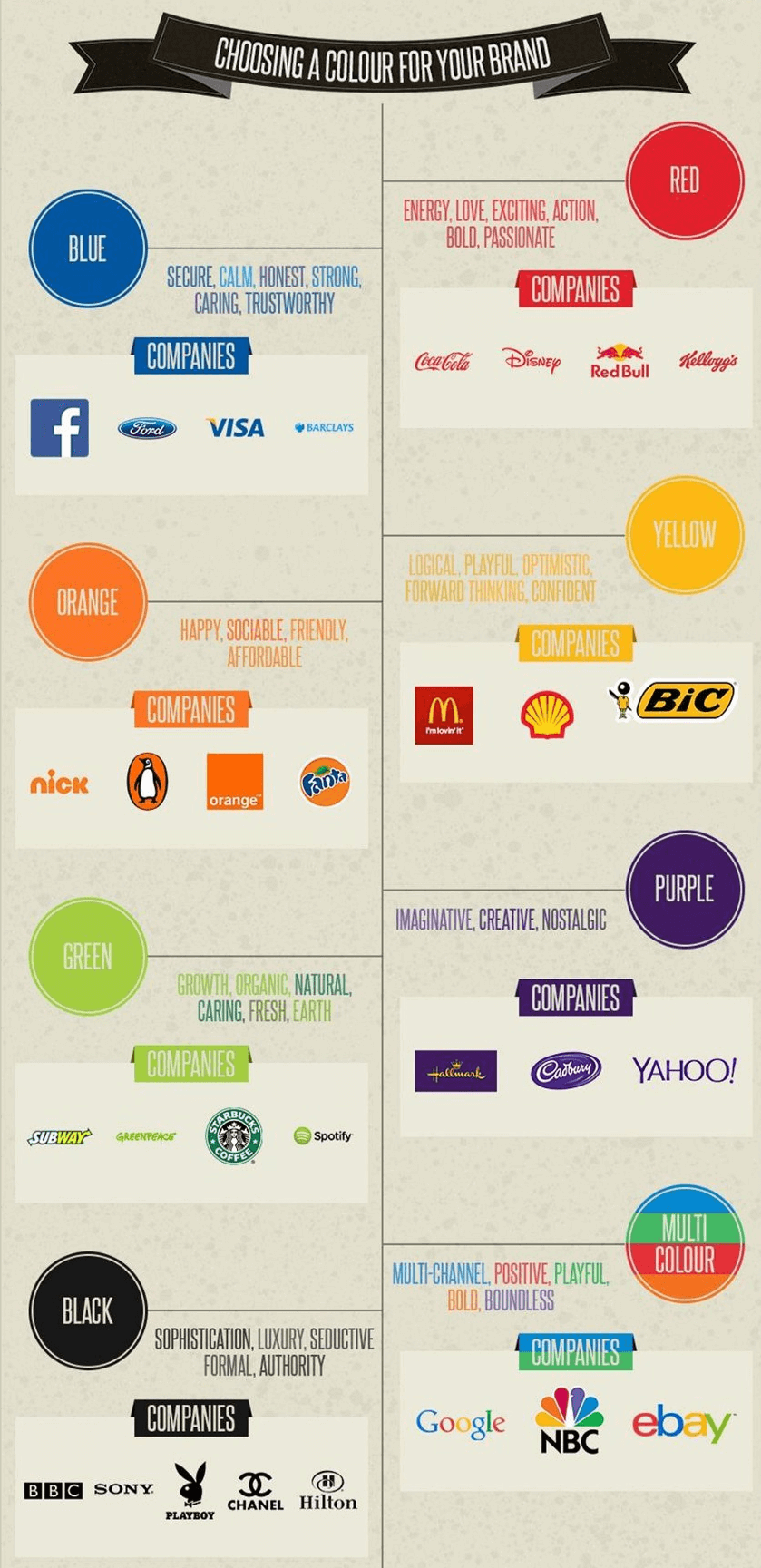
A logo is no longer a symbol for your company but an identifier that conveys meaning, i.e. your personality, ideals, and mission.
If you are new to logo design, here are the most popular types of logos you need to know:
- Monograms: HBO, CBS, NASA
- Logotypes: Coca-Cola, Casper, Google
- Logo symbols: Apple, Target, Shell
- Abstract logos: Pepsi, BP, Adidas
- Mascot logos: KFC, Wendy’s, Pringles
- Emblems: Warner Bros, Starbucks, BMW
Furthermore, if you feel creative, you can create logo combos like Doritos or Monopoly! Make it as fancy or as simple as you like. Go for the extravagant or the minimal!
At the end of the day, though, your logo should reflect your personal brand and help consumers identify you.
Also, don’t worry if, at some point, you feel like giving your logo a new look!
Throughout the years, numerous brands have gone through a brand logo revamp to make their logos more modern like Firefox, GAP, Windows, and so on!
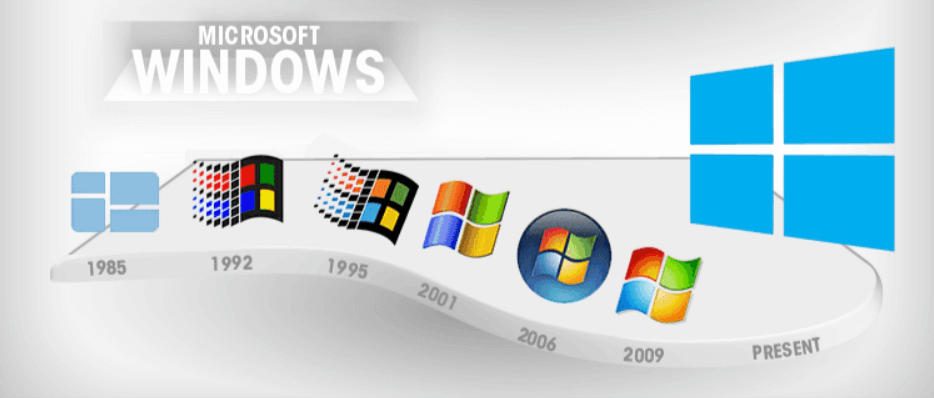
Coming up with a Clever Tagline
Apart from your logo, you also have to create a clever tagline to go with it!
The first thing you need to know is that your tagline is different from your slogan. More specifically, your tagline should be a short sentence that will highlight your brand’s purpose.
Kit Kat’s “Have a break, have a Kit Kat” and Mastercard’s “There are some things money can’t buy. For everything else, there’s MasterCard.” are great examples of memorable taglines.
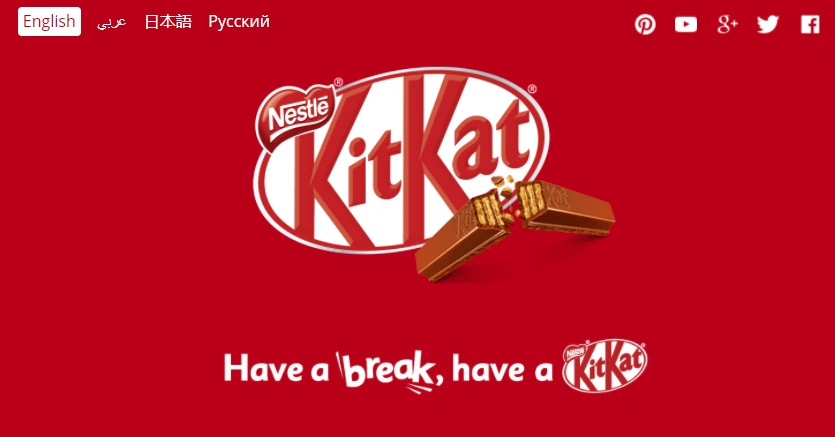
If you want to mimic them, you have to come up with taglines that communicate the benefit of choosing you over your competitor.
Slogans, on the other hand, are created for specific marketing campaigns and products. Usually, they are short-lasting and adapt to change.
For instance, Kit Kat has used the slogans “Break time, anytime” and “Breaks are good, have one” to promote specific campaigns.
Nevertheless, these were nothing compared to the original tagline that everyone knows!
7. Develop Your Brand Personality
To last in time, your brand needs to be intriguing and alluring.
To make it happen, you need to create a unique brand personality that will capture your target audience’s heart.
Building a personality for your brand requires you to attribute certain human characteristics to it.
When we usually talk about a brand personality we focus on the five main types of brand personalities:
- Excitement: carefree, spirited, and youthful
- Sincerity: kind, thoughtful, family-oriented
- Ruggedness: rough, athletic, outdoorsy
- Competence: successful, influential, accomplished
- Sophistication: elegant, prestigious, pretentious
Different brands fall under these five categories. For instance, Nike always displays a very youthful and spirited personality.
Apple, on the other hand, is more on the Sophistication side, promoting elegance and minimalism.
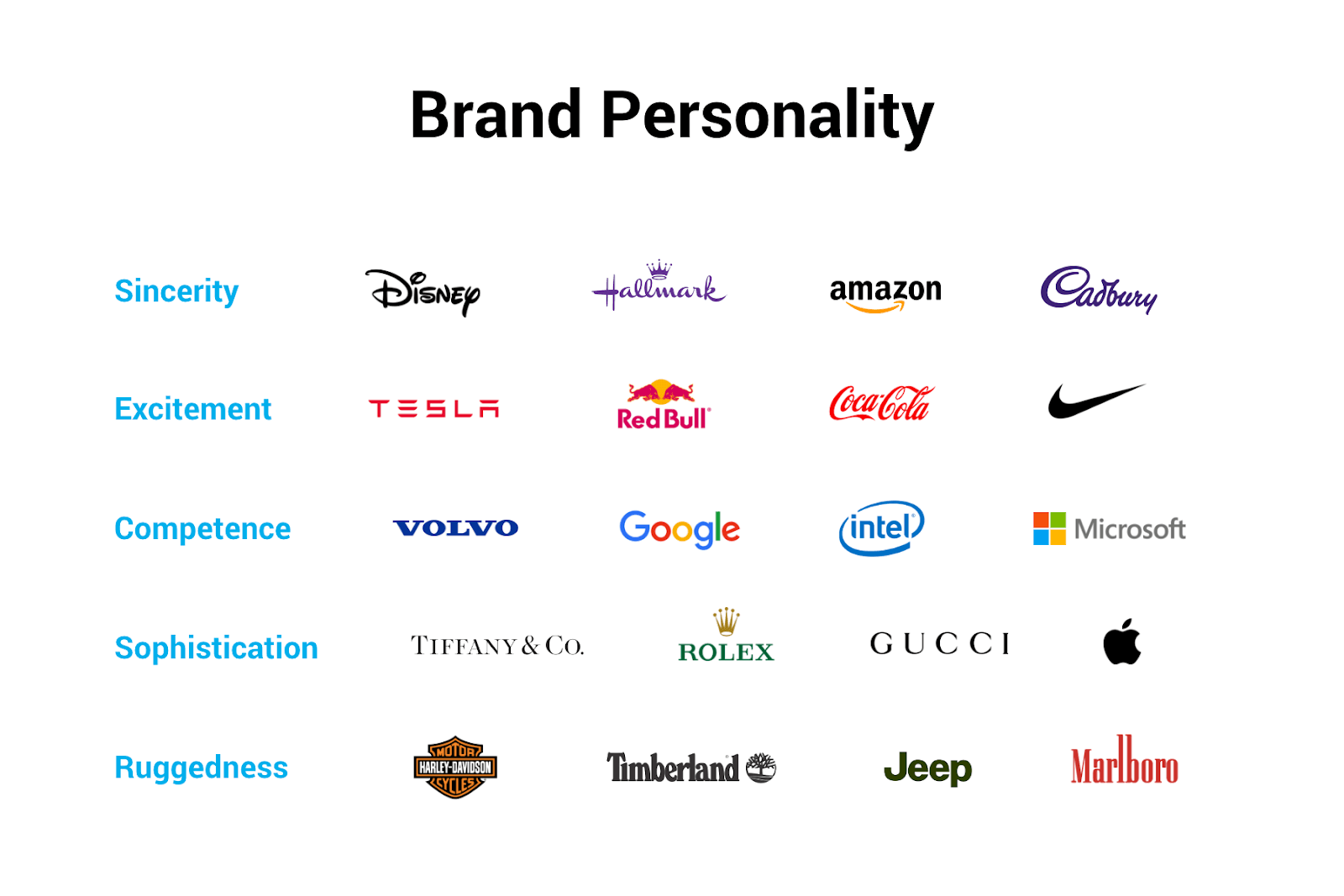
Assigning specific traits to your brand is the best way to humanize it and make it more relatable to your potential customers.
If you think that your brand personality is a trivial matter, I urge you to consider Jennifer Aaker’s words about the influence of brand personality on consumers. According to her, there’s now proof that a brand personality is a powerful weapon that can influence the bond between businesses and consumers.
Yet, the power of brand personalities is sadly overlooked when new business owners learn how to build a brand and it’s not used to the fullest.
To further support why you need to leverage brand personalities to the max, consider the following statistics:
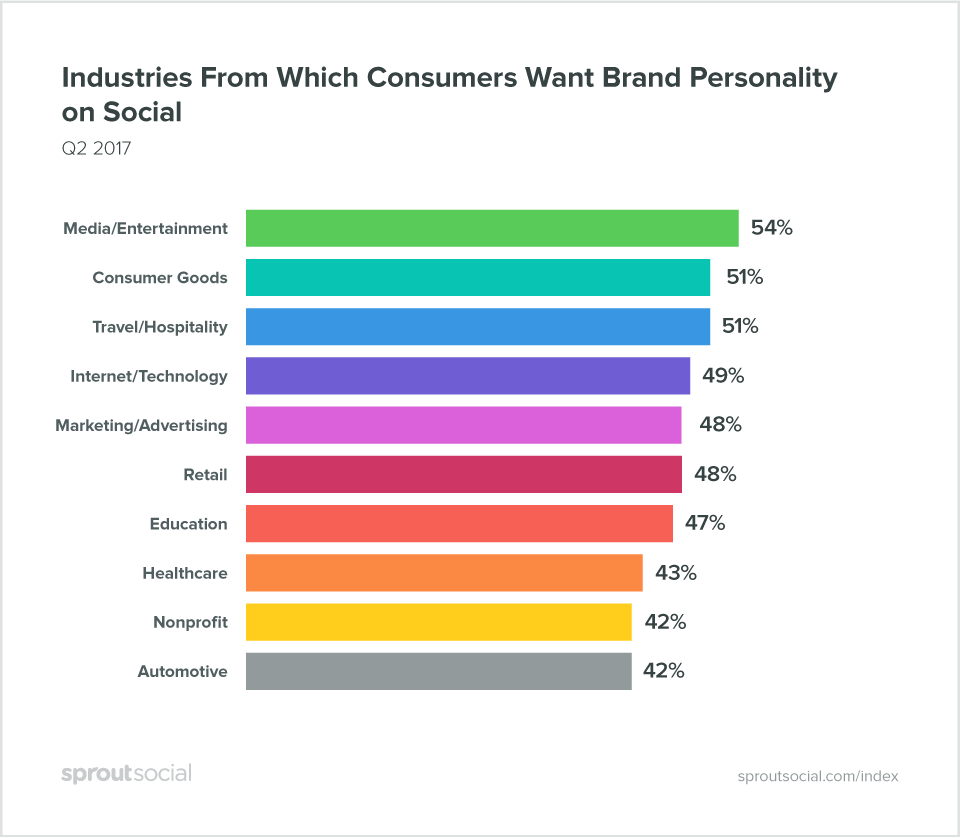
Consumers want businesses to have engaging personalities that will charm them, especially when it comes to the entertainment/media, consumer goods, and travel industries.
With this in mind, don’t forget to create a memorable and compelling personality for your brand as it will play a major role in your engagement and conversions.
Visual Identity vs Brand Personality
Before we move on to the next step, let’s see what visual identity is and why you shouldn’t confuse it with your brand personality.
As the name suggests, your visual identity is the perception your target audience has about your brand based on visual elements.
In simple terms, what your customers see is part of your brand’s visual identity. The purpose of creating one is to make an astonishing first impression that will influence your audience’s perception of you.
On the other hand, the personality of your brand is the emotional connections and traits that make your brand more “real.”
Your visual identity is the vehicle to promote that personality.
For example, here is Function of Beauty’s brand personality: youthful, playful, and friendly.
And here’s how this personality becomes visual:

Function of Beauty uses a beautiful color palette to embody the feeling of youthfulness and fun.
To use your visual identity and brand personality in tandem like Function of Beauty, make sure that your eCommerce store design triggers pleasant emotions and reflects your brand personality without being excessive!
8. Establish A Unique Brand Voice And Tone
With so many brands out there, you need to find a way to distinguish yourself from the crowd!
How? By developing a memorable voice and tone for your brand!
In short, brand voice is the personality you have created for your business. This personality will remain the same no matter what. Your tone of voice, on the other hand, refers to the way you express yourself in different situations. So, compared to your voice, you can adjust your tone based on the piece of content you create.
A clear voice will not only make your brand more personal but offer a consistent customer experience throughout your customer’s journey. Also, using the right tone will allow you to deliver more meaningful messages while staying on-brand.
To show you the importance of having a distinguishable voice, let’s examine Nike’s brand voice on Twitter:
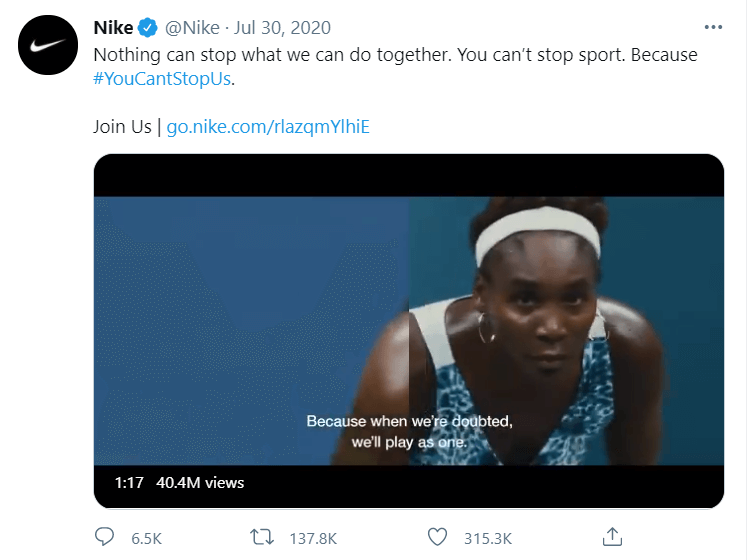
From this post we can see that Nike’s voice is:
- Determined: “Nothing can stop what we can do together.”
- Motivational: “You can’t stop sport.”
If you examine the brand’s Twitter content, you’ll also see how its posts center around the power of unity. For the brand, becoming a voice of inspiration and courage is all it takes to create an emotional connection with the audience.
Similarly, different brands will come up with their own brand voice to stand out from the crowd.
The best example comes from MoonPie:

The brand’s compelling voice was a product of the company’s social media marketing strategy revamp and its aspiration to engage more followers. Here, MoonPie has created an on-brand post to engage with social media followers in an entertaining way.
To find the optimal voice and tone for your brand, stay true to your personality and consider what your audience wants to see.
9. Create A Beautiful Story For Your Brand
Stories are part of our culture. So, it’s no surprise that consumers love it when marketers and business owners have great stories to share!
Using brand storytelling is one of the most impressive tactics you can use to connect/reconnect with new and existing customers. Effective stories, though, should follow a narrative that is both intriguing and converting.
Brands like Nike, Land Rover, and IKEA have leveraged this tactic to share storylines that will influence their audience on an emotional level.
Some of the most effective storytelling examples come from Coca-Cola, a brand that uses video marketing to spread the feeling of happiness and camaraderie.
Here’s Coca-Cola’s 2020 Christmas story:
The video has over 8 million views on YouTube with one of the viewers saying: “I’m not crying. You are.” This shows how powerful stories can impact consumers. Alone, Coca-Cola is just a company selling another refreshment. With the story, though, Coca-Cola is the means for reuniting a father with his daughter!
Whether you are a small business owner, a SaaS software company, a Startup, or an Agency, you can use stories to convey your brand’s message. The only things you need to get started are a compelling story idea and a brilliant execution!
10. Pick The Right Channels To Promote Your Brand
When we talked about brand building, we saw that promotion is an integral part of making it work. Luckily, business owners have various digital marketing tools at their disposal to build their brand.
Choosing the right channels for your niche is essential. To do it right, consider your target audience and the channels they use the most.
With this in mind, let’s see two of the most cost-effective channels you can leverage to promote your brand!
Email Marketing
It’s no surprise that the first one is email marketing!
With an estimated ROI of $42 for every $1 you invest, emails will help you build brand awareness, nurture your leads and skyrocket your revenue.
With the right email marketing strategy in place, you can target your audience with relevant content and personalized messaging.
The first thing you need to nail it is to choose an email marketing automation platform like Moosend or Mailchimp to design and automate your campaigns.
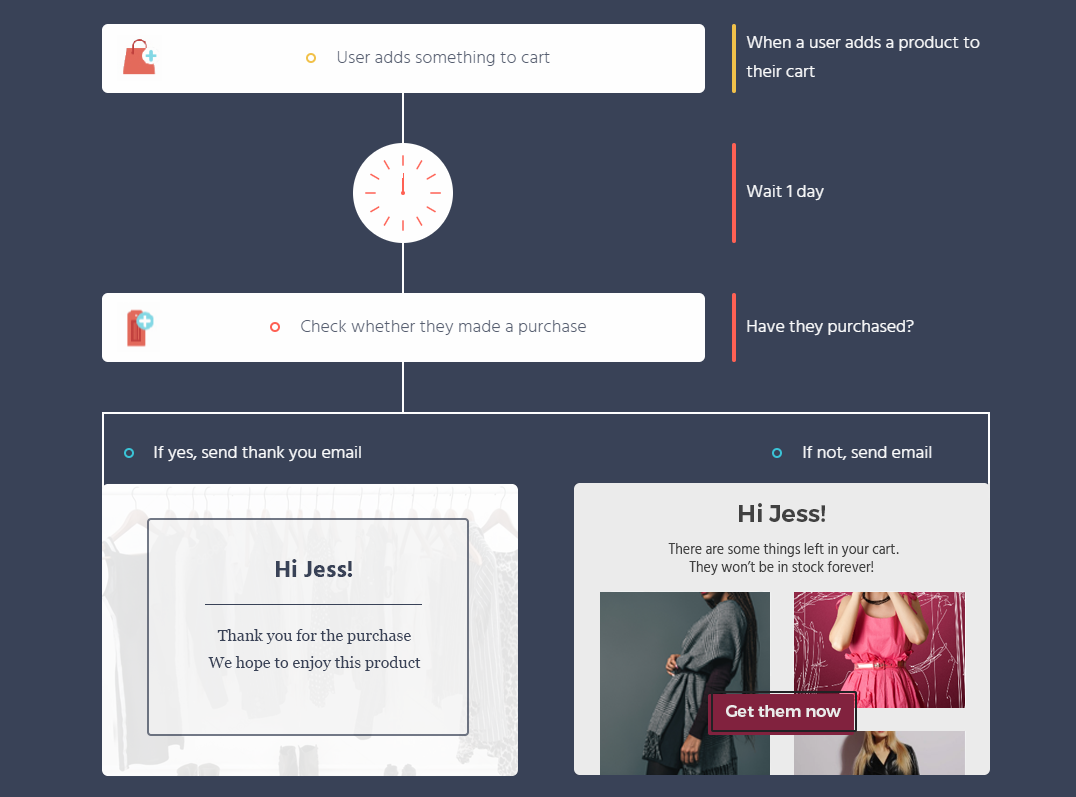
If you want to go far, though, make sure to choose a tool that will scale your business!
Moosend’s software, for example, is ideal for businesses that want advanced tools at an affordable price ($9/month). You can sign up for an account to test out its capabilities.
When you get the tools, it’s time to:
- create a welcome email template to greet new subscribers and familiarize them with your brand.
- segment your audience and deliver content tailored to their needs.
- design branded emails that will match your website’s color palette and visuals.
- use your brand voice throughout your messaging.
Here’s how Blizzard uses its unique voice and storytelling to create an unusual email campaign:
Subject line: Enter the Heartland of the Horde, Marilou!
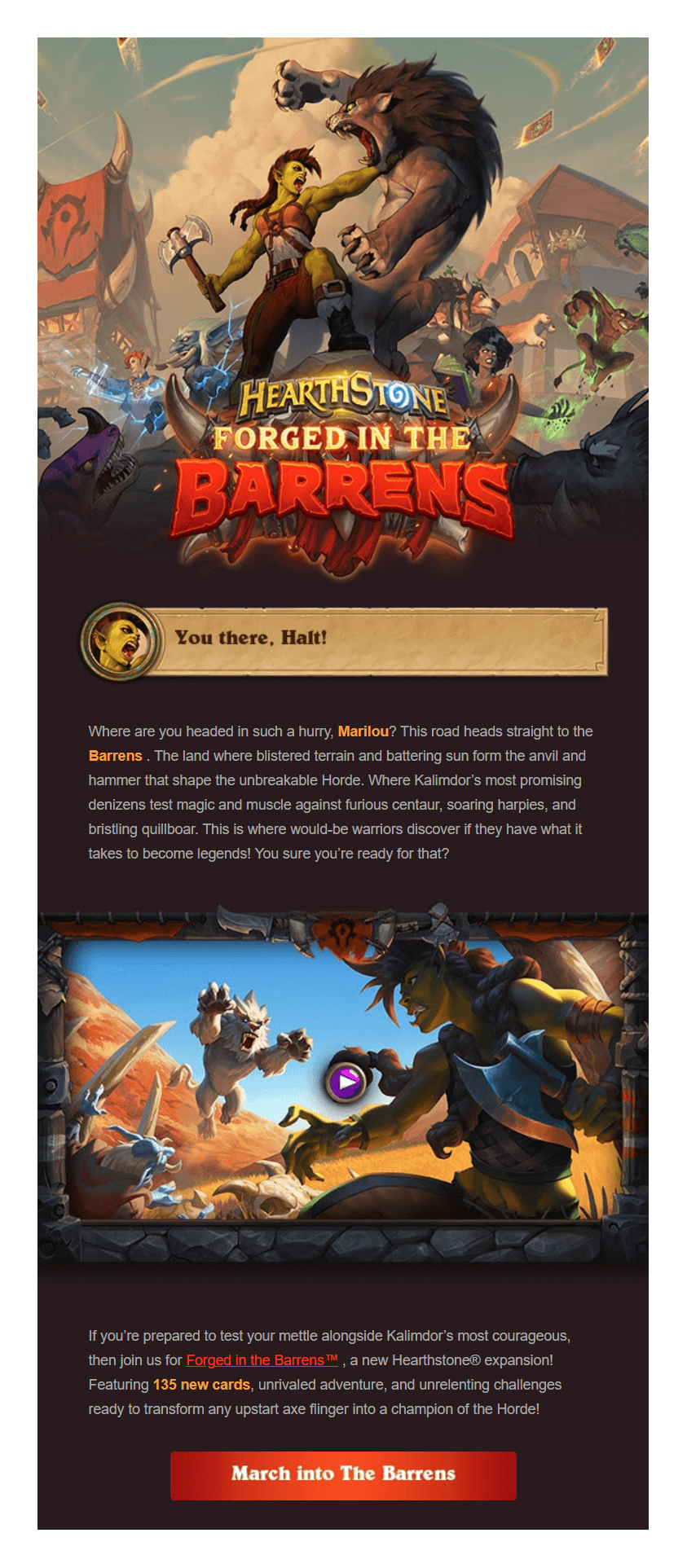
As you can see, Blizzard uses personalization to deliver a targeted campaign that charms the recipient.
Apart from that, the gaming company also uses visuals and role-playing to weave an unforgettable email story.
The result: subscribers immediately recognize Blizzard’s email newsletters and look forward to engaging with them!
Social Media
Social networks are one of the most popular channels you can use to power up your brand!
Here, you can choose between the organic or the paid traffic way. Or, for better results, combine them!
To boost organic traffic, you need to create social posts that will resonate with your followers. Of course, if you want to maximize your visibility and go viral, you need to come up with a clever post idea, using the right amount of brand personality and tone.
One of the best examples of combining all those elements comes from brands like Chubbies and Slim Jim.
In Chubbies’ case, the brand has a very specific content marketing strategy that highlights their fun and unexpected character:
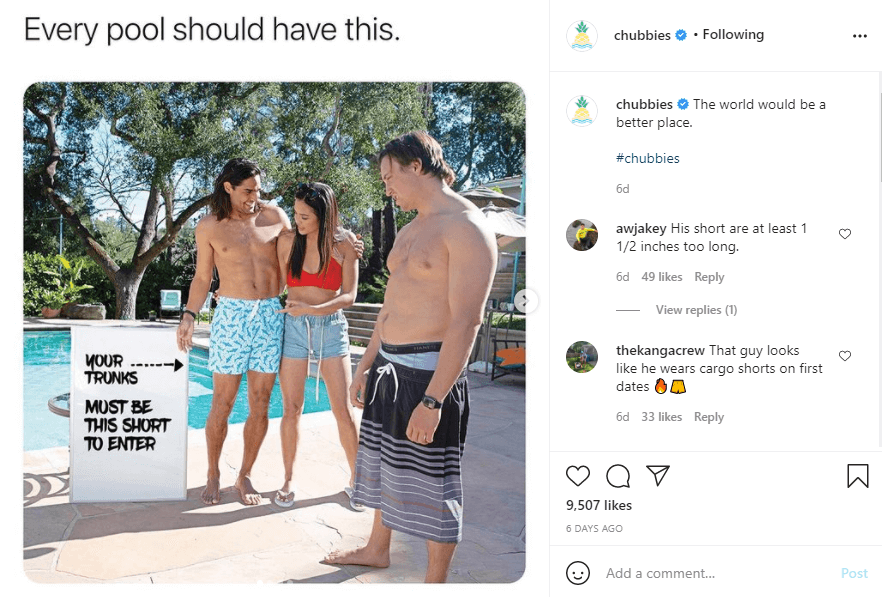
Slim Jim, on the other hand, usually creates product-related memes to entertain its audience.
The amount of likes and comments on its Instagram posts is truly astonishing, showing us that Slim Jim’s followers love the hilarious content:
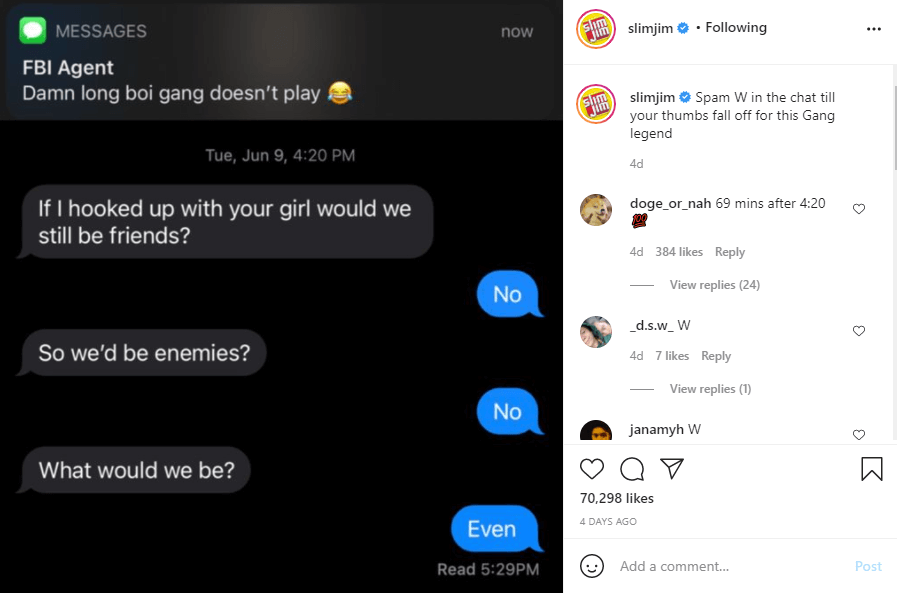
Now, if you want an extra boost, you can leverage the power of paid ads to target a bigger audience.
Like your posts, your ads should use similar language and visuals to provide your potential customers with a continuous brand experience.
Below you can see how Chubbies delivers a Facebook Ad that repurposes the user-generated content it usually posts on its Instagram account:
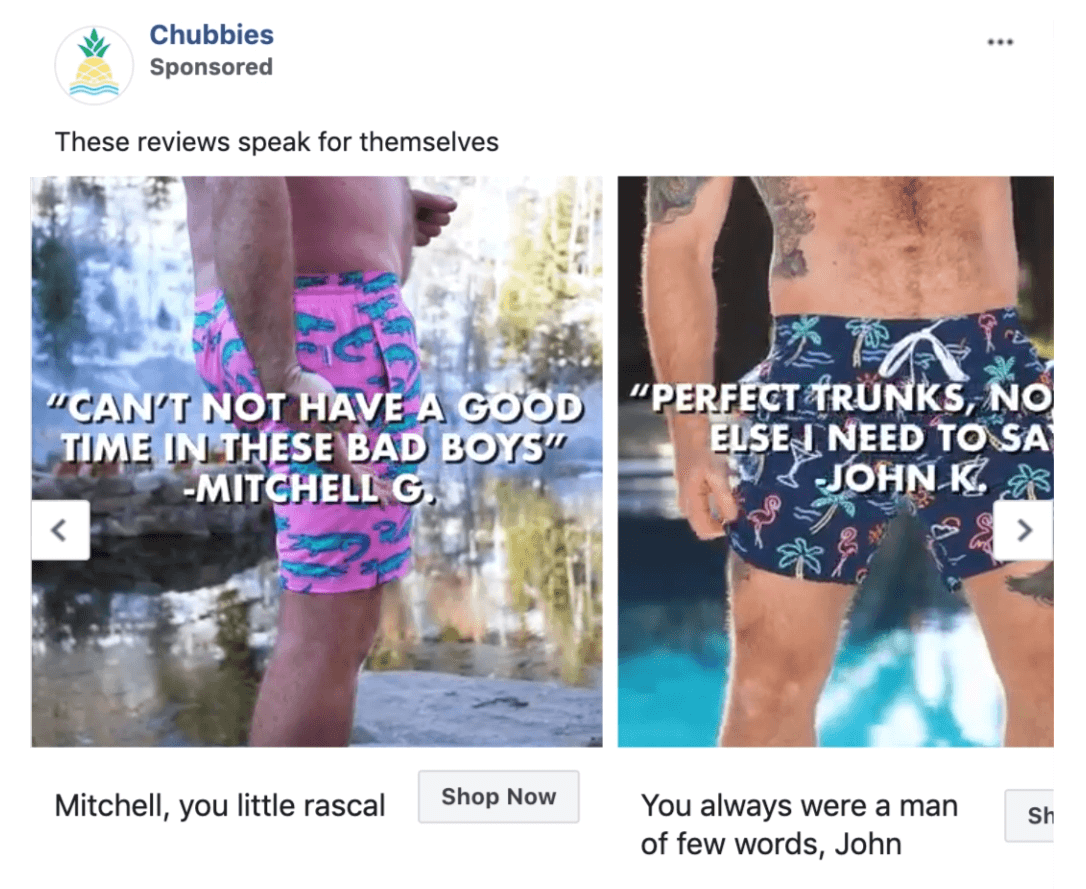
11. Turn Customers Into Advocates of Your Brand
Want to know how to build a brand that will be both credible and lovable? Well, the secret is to get your loyal customers to show others why they need to invest in your brand!
To spread the word, you need to turn your shoppers into advocates of your brand and collaborate with them! The best thing to achieve it is to approach social media influencers who use your products.
For eCommerce stores, Instagram media influencer marketing is a winning practice! Whether you have a small business or a big enterprise, partnering with influencers will give you access to their loyal audience and help you convert them.
For example, Kraft Macaroni and Cheese collaborated with NewDarlings to promote their gluten-free product:
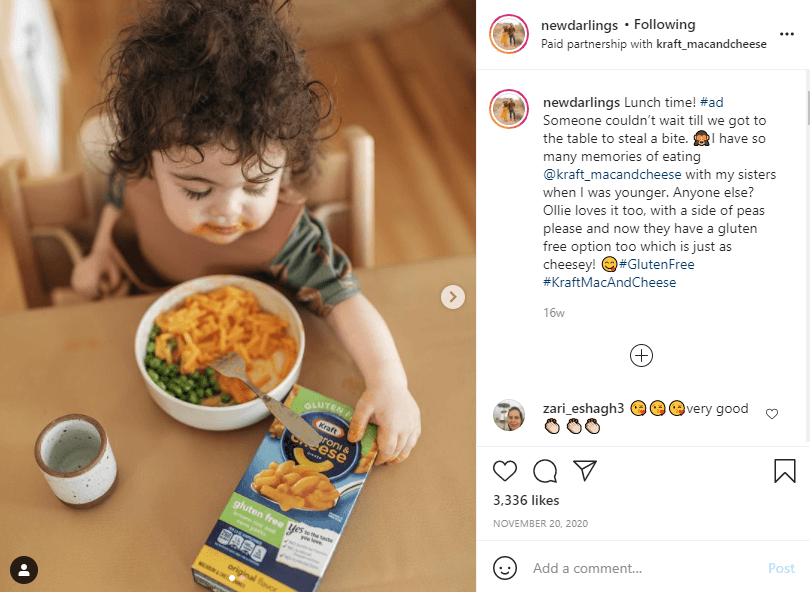
If you take a look at the brand’s website, you’ll see their positioning statement: “The part of parenting that’s impossible to mess up.”
So, you can see why Kraft chose to collaborate with NewDarlings (and their son) to promote its products.
If you want to increase brand awareness through influencer marketing, keep in mind that even smaller influencers (micro-influencers) can help you out.
While macro-influencers and celebrities might seem ideal to reach a huge audience, targeting micro or nano-influencers will give you access to an already-nurtured audience that will gladly follow their recommendations.
Keep in mind that the more an influencer appreciates you and your product, the easier it will be to promote it to their followers!
12. Embrace The Possibility Of Rebranding
Up to now, we saw how to create a brand that will win people’s hearts.
However, if you want to create a business that will last in time, you should be aware of the evil twin of branding: rebranding.
Rebranding is a marketing strategy that aims at changing specific parts of your brand like your name, concept, or logo for the purpose of altering consumers’ opinions.
A recent example of rebranding comes from EA’s game title “The Sims 4.” The company performed an aesthetic overhaul of the game, changing the box art and giving its logo a more modern look.
Of course, the change had to be addressed through an FAQ:
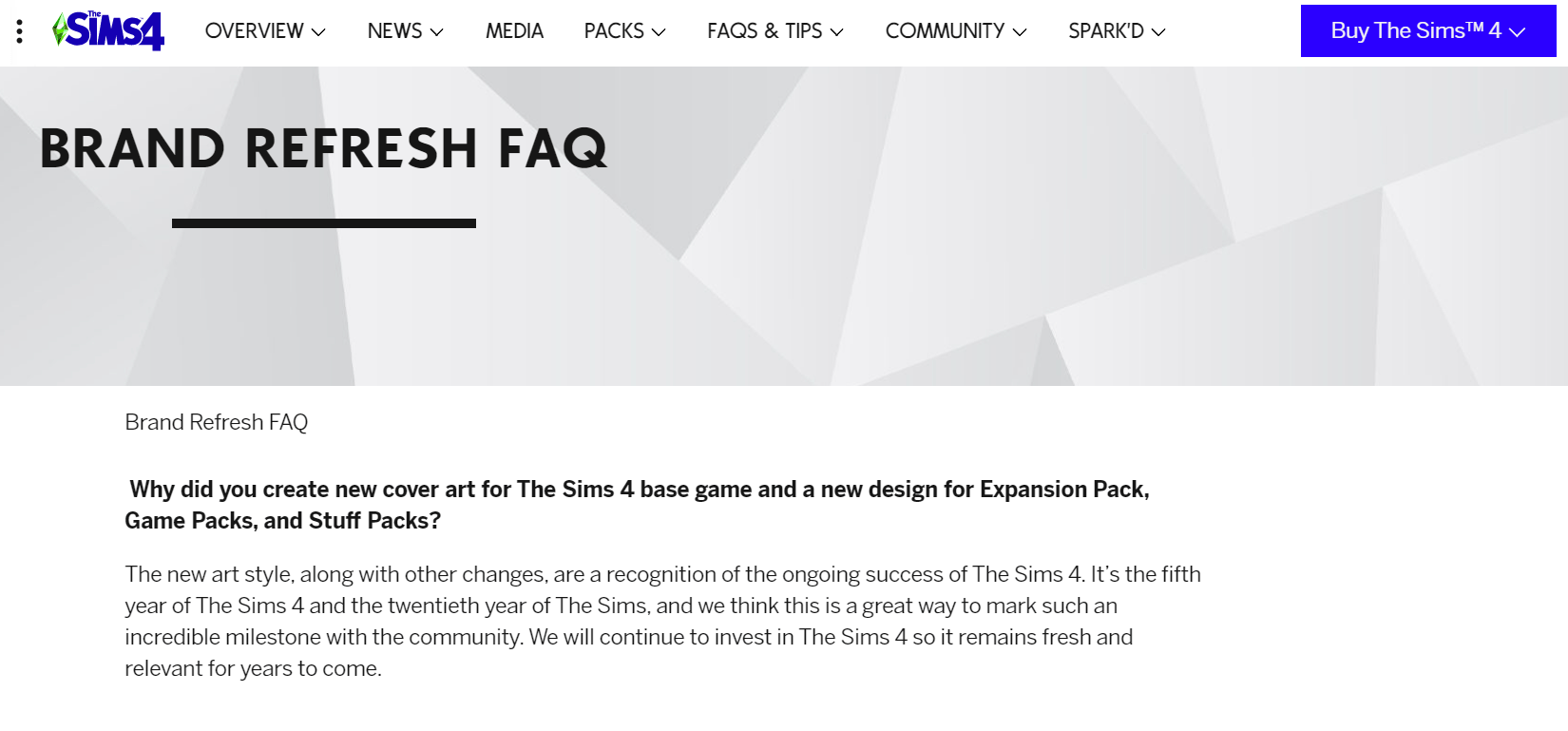
Changes like this are pretty common, especially when brands want to appeal to a larger audience or shift their focus.
For EA, the change was a strategic move to attract younger gamers who favor bright colors and modern designs. And while an FAQ is a great way to explain your rebranding, there’s an even better way to get the word out.
Let’s see!
Rebranding and Social Media
Rebranding can sometimes be a serious matter that can stir your target audience and cause mixed reactions.
That was the case with BigHit Entertainment’s plans to change its name to HYBE Corporation with the new tagline: “We believe in music.”
Netizens’ response was huge, with the change trending on Twitter for a few hours.
So, how did BigHit deal with the issue? Well, they used their best asset: their employees.
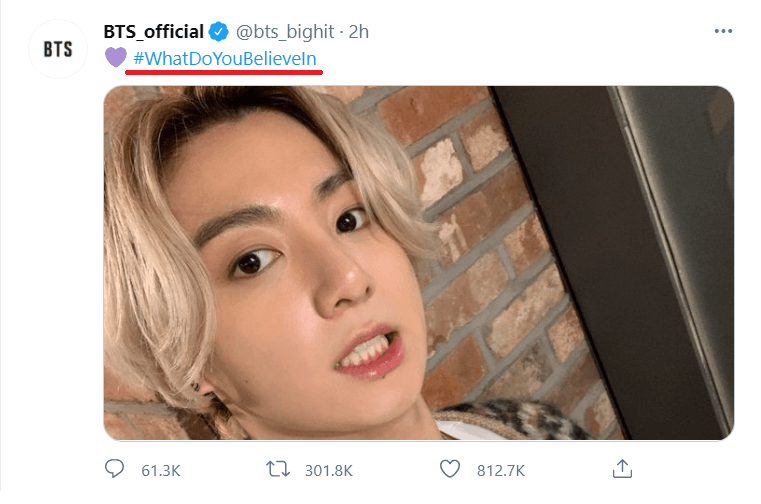
Of course, BigHit is no random company. Using their famous band, BTS, and other musicians under their label, the company promoted the new change with the hashtag #WhatDoYouBelieveIn.
This way, it managed to make the transition smoother and collect feedback from social media users.
Being prepared for a company rebrand is part of surviving in a very competitive market. So, if you need to make changes, don’t be afraid!
Like BigHit, get all your employees involved and let them know why changes need to happen. Then, leverage the immense power of social media to trigger positive engagement and show your followers the new you:
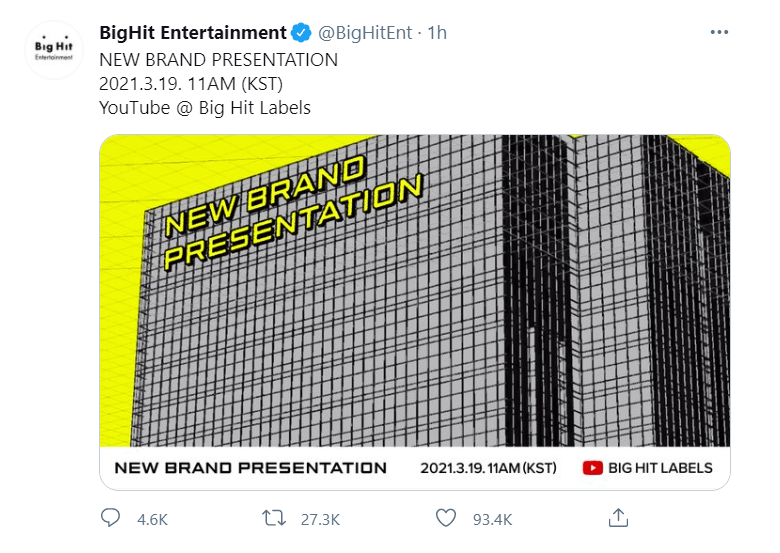
And don’t forget, a nice video presentation can work wonders.
Designing Your Brand Guidelines
Before I let you build that amazing brand of yours, let’s see a little thing called brand guidelines or brand style guide.
This “guide” usually includes your logo, color palette, design, mission statement, typography, tagline, and so on.
Creating brand guidelines is essential to keep all the elements of your company in a single place.
So, when you’ve finished with brand building, make sure to design your brand style guide for future reference!
To give you an idea, here’s an example from Herban Kitchen’s brand book:
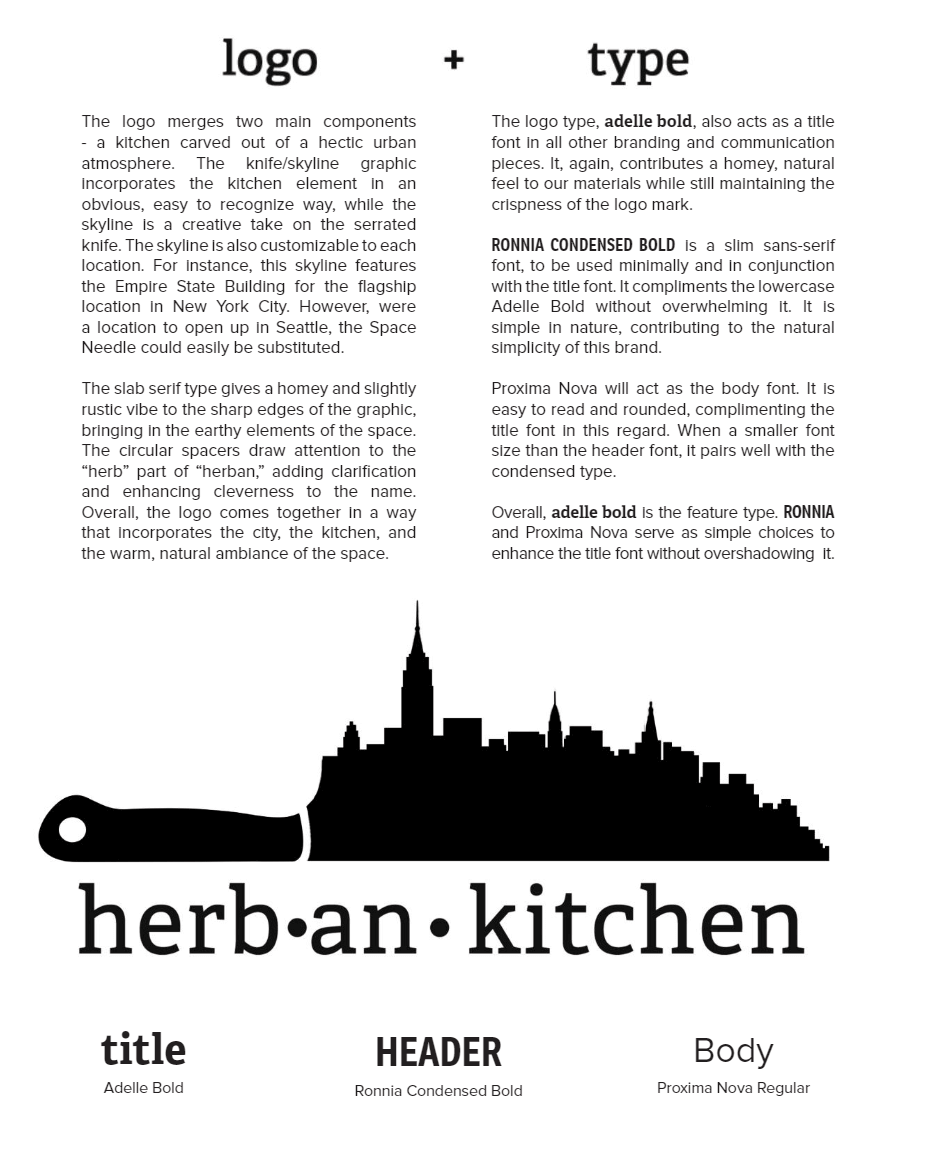
If you have trouble creating your guide, you can grab a brand guidelines template to help you out.
Then, you can start adding all the essential elements of your brand:
- Your history, mission statement, and goals.
- Brand voice and tone examples.
- Color palette and visuals for your brand and website.
- Logo breakdown and typography.
- Business card examples and fonts used.
Your guidelines can be as detailed as you like. The end goal is to give someone reading your style guide an idea of what your brand is about and what elements distinguish it from other brands.
Time To Build That Brand!
After reading this, I’m sure you know how to build a brand that will last in time!
From your logo and tagline to your mission statement and brand voice, creating a brand is all about turning a legal entity into a living and breathing thing that people will love.
Of course, to have a successful brand you need to find the right channels to promote it! Using email marketing and social media is the best way to nurture your customers and show them how cool you are.
If you still haven’t picked the right tools, it’s high time you did! Sign up for a Moosend account and create those amazing branded emails of yours!
Time is of the essence!
So, get out there and create a brand that everyone will love and admire!

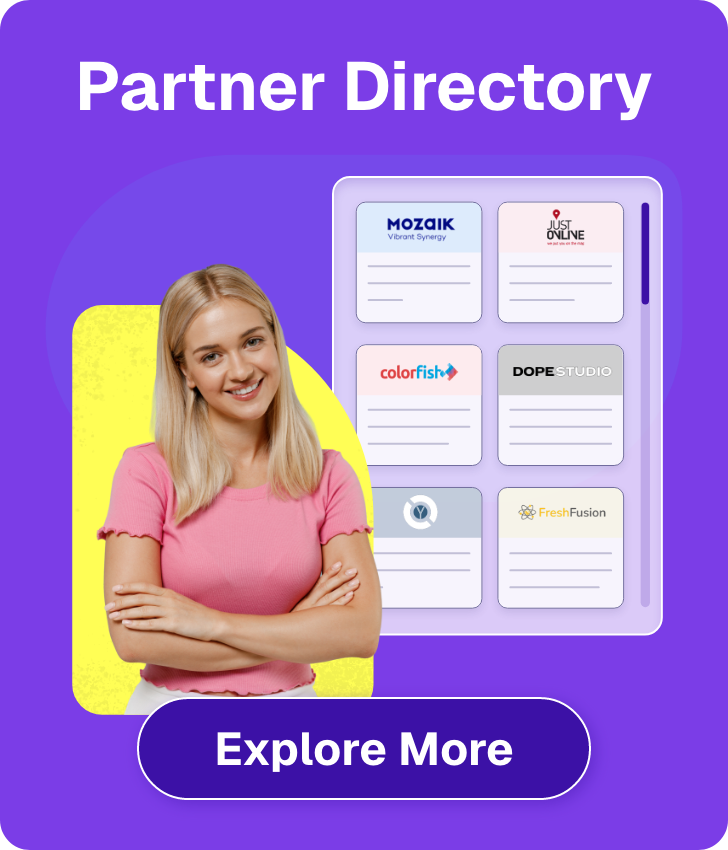


 Published by
Published by
